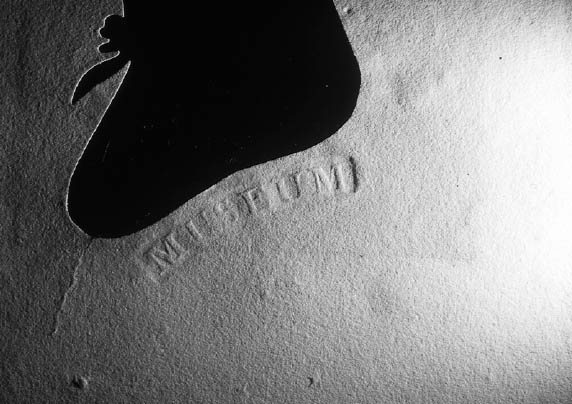PAPER PROFILES: AMERICAN PORTRAIT SILHOUETTESPENLEY KNIPE
6 BLIND STAMPS, TRADE LABELS, AND FORGERIESThe professional silhouettists like Edouart, Metford, Hubard, and the Peales often employed a stamp or label to identify their silhouettes. For example, the silhouettes cut at one of the Peale museums or by one of the Peale sons traveling with a physiognotrace were often stamped with one of three blind stamps, the most common being “MUSEUM” (fig. 7). “PEALE'S MUSEUM” and “PEALE” were the other stamps used, the former with an eagle bearing outspread wings.
Most of the time these stamps can be relied upon, but, like any artist's signature or identifying mark, there are some that are not what they purport to be. For example, Yale has a hollow-cut bust silhouette on beige machine-made wove paper and backed with an unattached black textile. The sitter is George Washington (Yale University Art Gallery, 1945.260). Underneath the bust, there is a blind stamp of an eagle with outstretched wings and the words “PEALE'S MUSEUM” under that. The hollow-cut paper measures 14.9 � 12.7 cm. This silhouette is a 1920s forgery; there are numerous examples of this forgery, with slight variations but sharing certain telling characteristics. The silhouettes are almost twice as large as an authentic Peale silhouette, and all have the embossed stamp first used by Rubens Peale in New York from 1825 to 1837. The stamp was acquired in the 1920s by New York antique-store owners Mr. and Mrs. Collins, and it is believed that the Collinses forged many Washington hollow-cuts. The stamp's placement on the forgeries is lower, and because the silhouettes are bigger, the stamp is smaller relative to the hollow-cut; on the authentic silhouettes the stamp is as wide as the base of the silhouette. The silhouette has other features that are similar to other fakes and distinguish it from real Peale silhouettes: the broadness of the cutting, the handling of the queue ribbons, the straight nose, and the undefined collar. That is, the cutting is less delicate and more generic (National Portrait Gallery Curatorial File; Laughon and Laughon 1986; Miller 1997b). Another reason for skepticism about the Washington silhouettes is due to the variations seen in the fakes; if the silhouettes were mass-produced for sale at the Peale Museums as mementos of Washington, they would likely all be the same. Nor is it insignificant that the figure is of national importance and the silhouette is “by” a famous name. Only these high-end fakes could command a price worth the effort in such a “cheap” art. Some labels tell more than simply the artist, the location and the price. Some, like those of Hubard, are particularly enlightening. Consider these two: “Cut with common Scissors, BY MASTER HUBARD, (aged 13 years) Without Drawing or Machine” (Museum of Fine Arts, Boston, 1981.475) and “This curious and much admired Art of cutting out Likenesses with common Scissors, (without drawing or machine) originated in this Establishment, in 1822” (Museum of Fine Arts, Boston, 1981.473). They remind the viewer both that the artist was a child prodigy and that he did not rely on a machine to make his portraits. This latter point is an important distinction. Many of the freehand artists felt their profiles were superior to and quite distinct One need not rely only on labels, stamps, and the occasional signature to assign attributions. Stylistic differences are often readily apparent. For example, Edouart left us many telltale signs of his work. The men usually have slit buttonholes and cutaway collars with a piece of white paper inserted underneath. The figures' feet are usually long, thin, and dangling. As mentioned, Chamberlin had a signature collar he both cut and then drew on. Often the way the base of the bust of a hollow-cut is handled can be a clue. Certain artists cut a small notch in the bust or shaped it in a characteristic way. For all the talk of the mass production or cheapness of this art, many of the silhouettists, like other artists, had individual styles. Still, there are thousands of silhouettes crafted by now unknown people, perhaps the sitter's sister, perhaps a traveling profilist or sign and banner painter. |
